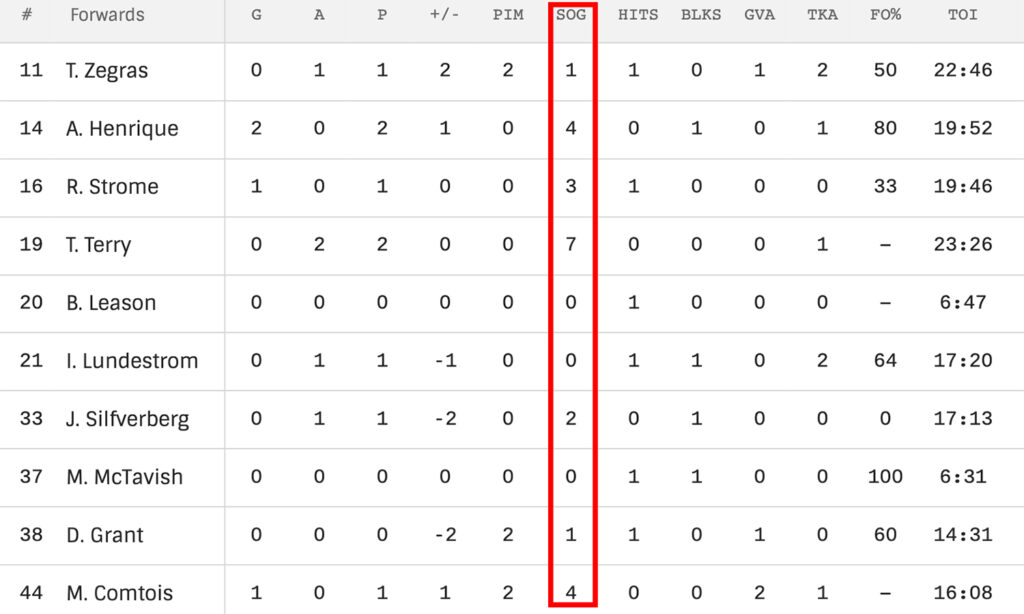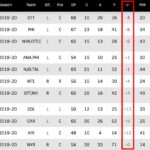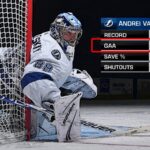Whether you’re attending an NHL match or watching it on TV, you’re typically bombarded with various game stats.
You’ll see details such as the score, the time remaining and the period throughout the game.
This allows you to gauge the flow of the game, especially when you have a dog in the fight.
But the stats don’t end there.
You’ll be subject to team stats such as their winning record along with individual stats such as goals, assists, points and so forth.
One stat that individual players and teams share in common is SOG.
The sum of player SOGs is reported as the team total for that game.
What does SOG mean in Hockey?
SOG is an acronym for shots on goal in hockey. A shot on goal is defined as any shot saved by the goalie or that breaches the goal line. The stat appears on the venue scoreboard and is updated during live gameplay. Shots on goal are also recorded in the official game summaries.
If you’re looking for the SOG stat on the scoreboard, it is found next to each team’s score, typically in smaller print.
The scorekeeper adds the shot tally throughout the game, but these values are reviewed and can be revised.
Think of a player left alone in front of the net and trying to jam through shot after shot on a sprawling goalie.
The off-ice officials will need to review how many shots the player attempted in the end.
However, during live action, the scorekeeper will attribute the initial raw count.
In the end, the shots on goal are attributed to individual players and added to various stats.
If you were to look up both player and goalie stats, there are certain columns that correlate to the shots on goal (SOG).
For players, those columns are S (Shots) and S% (Shooting Percentage).
Shots on Goal and Shooting Percentage
If you look at the individual game stats for any game, the shots on goal for each player is provided.
These shots on goal are added to a player’s season and career totals.
The league uses the shot totals with reference to their goal count to determine a player’s shooting percentage.
If you’d like to learn more about shooting percentages, make sure to check out my post here titled What is the Average NHL Shooting Percentage?
Meanwhile, for goaltenders, you have columns SA (Shots Against), Svs (Saves) and Sv% (Save Percentage) that stem from shots on goal.
Shots Against
The Shots Against stat is the total amount of shots on goal for that particular goalie on the season.
Saves and Save Percentage
If you subtract the number of goals against from the total shots on net, you’re left with the amount of saves a goalie’s made.
The league uses these values to calculate the goaltender’s save percentage on the season or throughout their career.
If you’d like to learn more about how to calculate the save percentage, make sure to check out my blog post called What is the Average Save Percentage in the NHL?
What constitutes a shot on goal?
As defined earlier, a shot on goal is a shot stopped by the goalie or one that directly converts into a goal.
But there are some situations where a shot on goal is more ambiguous.
What if a player shoots on their own goalie? What if the puck hits the post? What about shots on the shoot out?
Let me cover all the scenarios that came to mind.
What’s funny is that I had to look some of these up for clarification.
Shot off the Post?
When the puck directly hits the post on a shot attempt, it is not considered a shot.
It’s as if the puck missed the net altogether.
This only holds true if the goalie doesn’t touch the puck whatsoever.
Meanwhile, if the goalie catches or blocks a shot that was going wide, he will be rewarded with a save. And the opposing team will be credited with a shot on net.
In the end, the team will be credited with a shot attempt, which is the sum of missed and credited shots during a game.
Tip-In Shots and Redirects?
There are four possibilities when it comes to tip-ins and redirects, all resulting in a shot on goal.
If a tip-in or redirect is caused by a teammate, the last player to touch the puck before reaching the net is awarded with the shot.
Should they score on the play, the original shooter would be credited with an assist only.
Meanwhile, if a player on the defending team tips or redirects a puck on net, the original shooter is attributed the shot.
Penalty Shots?
Only during regulation or overtime can a player be awarded a penalty shot.
The rules for penalty shots are similar to regular play. If the puck is stopped or crosses the goal line, the player will be credited for a shot on goal.
If the puck goes wide or hits the post, it’s considered no “shot on net”.
As a note, players are only allowed one attempt for a shot, meaning they cannot pick up their own rebound on the penalty shot.
Shoot-Outs Shots?
If the game is still tied after overtime, the teams go to a shoot-out.
The rules for the shoot-out are the same as penalty shots, except the shots and goals are not counted towards standard game stats.
Shots and goals scored in the shoot-out are kept separate and will not appear in career stats such as save percentage (goalies) or shooting percentage (players).
The winning team in the shoot-out will be credited with the extra goal, but that does not change the total shots on goal in the game summary.
Blocked Shots?
If a player attempts a shot on net, but gets blocked along the way, it will not be recorded as a shot on goal.
Blocked shots are typically deliberate or accidental.
Sometimes players on the same team are caught in the line of fire trying to screen the goalie. In the end, they get hit by friendly fire.
When the defending team blocks a shot on goal, they are awarded with a Blocked Shot.
In fact, there is an official leaderboard for NHL Shot Blockers.
Shots that miss the net or go wide?
Shots that either go wide or over the net are the same as shots that hit the post directly.
They are not considered official shots, simply a shot attempt.
The puck must touch the goalie or the cross the goal line to be considered a shot.
Which brings us to…
Own goals?
If a player shoots the puck on their own net and manage to score, the opposing team will be awarded both the goal and the shot on net.
In fact, the last player to touch the puck on the opposite team will be credited with the goal and the shot.
There is an exception to this rule, though…
Guaranteed goals?
When the goalie is pulled for an extra attacker, the opposition has a chance to score on an the empty net.
Whenever a team pulls their goalie for an extra attacker, they cannot use illegal tactics to prevent a guaranteed empty net goal.
For example, the defending team cannot throw their stick, trip a player on the empty net breakaway or even dislodge the net.
As a result, the referee will signal an automatic goal, even if the puck carrier never attempted to shoot.
For reference, see this game summary where Eric Staal scored two goals off a single shot. That's because he was awarded an automatic goal when he was hooked on an empty net breakaway.
Final Thoughts
You now know the meaning of SOG and what constitutes (or doesn’t) a shot on goal.
However, we didn’t go into the specifics of the various shot types.
Are you curious to know which shots on goal are the most successful for scoring?
Do you want to know which shot types are used the most and from where on the ice?
Make sure to read my post here on How Most NHL Goals are Scored.
This is an exclusive piece which details where you need to shoot from in the attacking zone to find scoring success.






